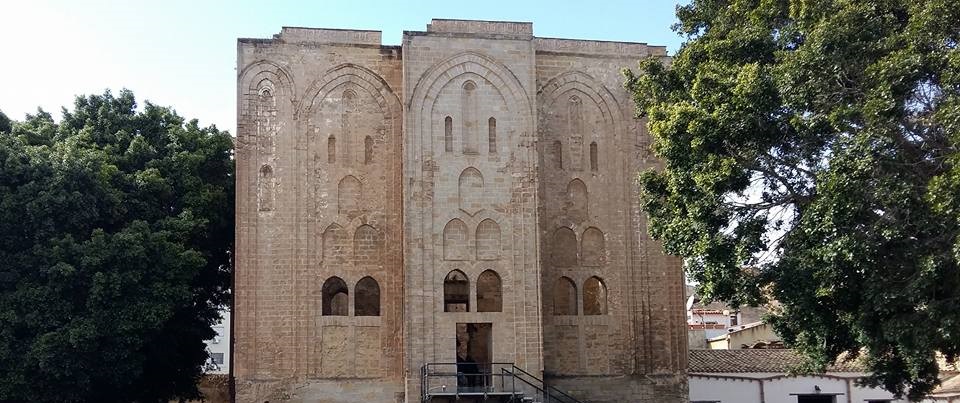
Read English version
In Corso Calatafimi al n° civico 100 si trova lingresso seicentesco della Cuba, uno dei “sollazzi” normanni del Genoardo (il grande parco che circondava il Palazzo Reale).
Serviva per il riposo diurno e il sollazzo del Re Guglielmo II che lha fatta edificare nel 1180.
Il nome, molto probabilmente, deriva dal termine arabo cubai, cioè costruzione coperta da volta. Ledificio era immerso in un grande bacino d’acqua.
Linterno è diviso in vari ambienti sistemati intorno ad una grande sala quadrata scoperta, un tempo porticata e con grandi archi retti da colonne, al centro del quale si trovava un impluvium a forma di stella ad otto punte.
Sul lato orientale si apre una sala con nicchie angolari introdotte da colonnine inalveolate; sul fronte opposto è il vestibolo che un tempo era mosaicato.
Allesterno ledificio si presenta come un perfetto parallelepipedo da cui sporgono appena, al centro dei prospetti, quattro elementi quadrangolari.
Ledificio è stato realizzato in conci di tufo perfettamente squadrati e presenta delle leggere modanature allesterno e una fascia epigrafica di grande plasticità, con iscrizione nashi, come cimasa.
Dopo lo splendore del periodo normanno la costruzione ha conosciuto lunghi periodi di incuria e di abbandono. E’ stata utilizzata come lazzaretto e come caserma. Tra il 1918 e il 1925 ha subito forti restauri a cura dellarch. Valenti e dallora la vita del monumento ha ripreso vigore ed esso oggi è visitabile. Una mostra documentaria sulla Cuba e sui restauri è disposta nei locali vicini
INDIRIZZO corso Calatafimi, 100 (caserma Tukory) Contatti: 0916391111 81015 81011
Visite: da Martedì a Giovedì 9,00am – 01,30pm. Venerdì e Sabato 09.00 am /06.30 pm. Lun, Dom e festivi chiusi. Ticket.
Ticket.
*ENGLISH
At 100 Corso Calatafimi , there is the seventeenth-century entrance of the Cuba, one of Norman “sollatii” recreations of the Genoardo (the large park surrounding the Royal Palace). It was used for daytime rest and solace of King William II who built it in 1180.
The name most likely derives from the Arabic “CUBAI”, that is building covered by vault. The building was surrounded by a large pool of water.
The interior is divided into various rooms arranged around a large uncovered square room , once there was a portico with large arches supported by columns. In the center there was an eight-pointed star shaped impluvium tank, where water was preserved.
On the eastern side there is a room with corner niches introduced by embedded columns; on the opposite side there is the hall, which was once a mosaic.
The exterior building is a perfect parallelepipedon from which, at the center of each facade, one quadrangular element slightly protrudes.
The building has been made up with tuff blocks perfectly squared and displays light mouldings outside and an epigraphic band of great plasticity, with nashi inscription , such as a sort of moulding, the cymatium..
After the flourishing Norman period the building had been neglected for a long time. It was used as a hospital and as barracks. Between 1918 and 1925 it had significant interventions and restoration by the architect Valenti and the monument came back to shine and now it is open to visitors. A documentary exhibition about the Cuba and its restoration is placed in the adjacent rooms.
Address: Corso Calatafimi, 100 . website
The name most likely derives from the Arabic “CUBAI”, that is building covered by vault. The building was surrounded by a large pool of water.
The interior is divided into various rooms arranged around a large uncovered square room , once there was a portico with large arches supported by columns. In the center there was an eight-pointed star shaped impluvium tank, where water was preserved.
On the eastern side there is a room with corner niches introduced by embedded columns; on the opposite side there is the hall, which was once a mosaic.
The exterior building is a perfect parallelepipedon from which, at the center of each facade, one quadrangular element slightly protrudes.
The building has been made up with tuff blocks perfectly squared and displays light mouldings outside and an epigraphic band of great plasticity, with nashi inscription , such as a sort of moulding, the cymatium..
After the flourishing Norman period the building had been neglected for a long time. It was used as a hospital and as barracks. Between 1918 and 1925 it had significant interventions and restoration by the architect Valenti and the monument came back to shine and now it is open to visitors. A documentary exhibition about the Cuba and its restoration is placed in the adjacent rooms.
Address: Corso Calatafimi, 100 . website
Visits: Tue to Thu from 9.00 am to 01.30 pm. Fri to Sut from 09.00am to 06.30pm- Mon, Sun & Holiday closed. Ticket.
For information 091 6391111 81015 81011. Free entrance first Sunday of each month
For information 091 6391111 81015 81011. Free entrance first Sunday of each month
